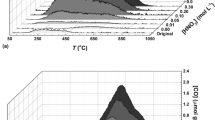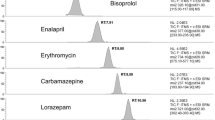Abstract
A simple, rapid and efficient solid-phase extraction method based on synthesized carbon nanodots was developed for the preconcentration and extraction of personal care products and organophosphorus pesticides in environmental matrices. Factorial (screening) and central composite designs were employed for the optimization of experimental conditions that could potentially influence the percentage recoveries of the target analytes. The experimental variables, including sample pH, mass of adsorbent, eluent volume and sample volume, were examined. Under the optimized conditions, the developed method was validated, and acceptable analytical results obtained showed good performance. The method accuracy carried out at two spiking levels (10 and 100 μg L−1) in different sample matrices ranged between 63 and 120%. The method precision based on relative standard deviation (% RSD) was < 10%. The linear range studied had a determination coefficient of (R2 > 0.995). The limits of detection (LOD) and limit of quantification (LOQ) established varied between 0.015–0.125 and 0.05–0.415 μg L−1 ,respectively. The ensuing method was applied successfully in the determination of the five multi-class organic compounds under study, in influent and effluent wastewater matrices, sampled from a municipal wastewater treatment plant located in Pretoria, South Africa.







Similar content being viewed by others
References
Muñoz I, Gómez MJ, Molina-Díaz A, Huijbregts MA, Fernández-Alba AR, García-Calvo E. Ranking potential impacts of priority and emerging pollutants in urban wastewater through life cycle impact assessment. Chemosphere. 2008;74(1):37–44.
Gwenzi W, Chaukura N. Organic contaminants in African aquatic systems: current knowledge, health risks, and future research directions. Sci Total Environ. 2018;619-620:1493–514. https://doi.org/10.1016/j.scitotenv.2017.11.121.
Gusmaroli L, Insa S, Petrovic M. Development of an online SPE-UHPLC-MS/MS method for the multiresidue analysis of the 17 compounds from the EU “Watch List”. Anal Bioanal Chem. 2018;410(17):4165–76. https://doi.org/10.1007/s00216-018-1069-8.
Varjani SJ, Chaithanya Sudha M. Treatment technologies for emerging organic contaminants removal from wastewater. In: Bhattacharya S, Gupta AB, Gupta A, Pandey A, editors. Water remediation. Singapore: Springer Singapore; 2018. p. 91–115. https://doi.org/10.1007/978-981-10-7551-3_6.
Songa EA, Okonkwo JO. Recent approaches to improving selectivity and sensitivity of enzyme-based biosensors for organophosphorus pesticides: a review. Talanta. 2016;155:289–304. https://doi.org/10.1016/j.talanta.2016.04.046.
Ml F, Pérez S, Kantiani L, Barceló D. Fate and toxicity of emerging pollutants, their metabolites and transformation products in the aquatic environment. TrAC Trends Anal Chem. 2008;27(11):991–1007. https://doi.org/10.1016/j.trac.2008.09.010.
Sibiya I, Olukunle O, Okonkwo O. Seasonal variations and the influence of geomembrane liners on the levels of PBDEs in landfill leachates, sediment and groundwater in Gauteng Province, South Africa. Emerg Contam. 2017;3(2):76–84.
Maldaner L, Jardim ICSF. Determination of some organic contaminants in water samples by solid-phase extraction and liquid chromatography–tandem mass spectrometry. Talanta. 2012;100:38–44. https://doi.org/10.1016/j.talanta.2012.08.006.
Ma X, Wan Y, Wu M, Xu Y, Xu Q, He Z, et al. Occurrence of benzophenones, parabens and triclosan in the Yangtze River of China, and the implications for human exposure. Chemosphere. 2018;213:517–25. https://doi.org/10.1016/j.chemosphere.2018.09.084.
Mashile G, Mpupa A, Nomngongo P. In-syringe micro solid-phase extraction method for the separation and preconcentration of parabens in environmental water samples. Molecules. 2018;23(6):1450.
Esplugas S, Bila DM, Krause LGT, Dezotti M. Ozonation and advanced oxidation technologies to remove endocrine disrupting chemicals (EDCs) and pharmaceuticals and personal care products (PPCPs) in water effluents. J Hazard Mater. 2007;149(3):631–42. https://doi.org/10.1016/j.jhazmat.2007.07.073.
Bebianno MJ, Gonzalez-Rey M. Ecotoxicological risk of personal care products and pharmaceuticals. Aquat Toxicol: academic Press; 2015. p. 383–416. https://doi.org/10.1016/B978-0-12-800949-9.00016-4.
Jiang J-J, Lee C-L, Fang M-D. Emerging organic contaminants in coastal waters: anthropogenic impact, environmental release and ecological risk. Mar Pollut Bull. 2014;85(2):391–9.
Montesdeoca-Esponda S, Checchini L, Del Bubba M, Sosa-Ferrera Z, Santana-Rodriguez JJ. Analytical approaches for the determination of personal care products and evaluation of their occurrence in marine organisms. Sci Total Environ. 2018;633:405–25. https://doi.org/10.1016/j.scitotenv.2018.03.182.
Frenich AG, Romero-González R, del Mar Aguilera-Luiz M. Comprehensive analysis of toxics (pesticides, veterinary drugs and mycotoxins) in food by UHPLC-MS. TrAC Trends Anal Chem. 2014;63:158–69. https://doi.org/10.1016/j.trac.2014.06.020.
Tran NH, Chen H, Do TV, Reinhard M, Ngo HH, He YZ, et al. Simultaneous analysis of multiple classes of antimicrobials in environmental water samples using SPE coupled with UHPLC-ESI-MS/MS and isotope dilution. Talanta. 2016;159:163–73. https://doi.org/10.1016/j.talanta.2016.06.006.
Pedrouzo M, Borrull F, Marcé RM, Pocurull E. Ultra-high-performance liquid chromatography–tandem mass spectrometry for determining the presence of eleven personal care products in surface and wastewaters. J Chromatogr A. 2009;1216(42):6994–7000. https://doi.org/10.1016/j.chroma.2009.08.039.
Celano R, Piccinelli AL, Campone L, Rastrelli L. Ultra-preconcentration and determination of selected pharmaceutical and personal care products in different water matrices by solid-phase extraction combined with dispersive liquid–liquid microextraction prior to ultra high pressure liquid chromatography tandem mass spectrometry analysis. J Chromatogr A. 2014;1355:26–35.
Spietelun A, Marcinkowski Ł, de la Guardia M, Namieśnik J. Recent developments and future trends in solid phase microextraction techniques towards green analytical chemistry. J Chromatogr A. 2013;1321:1–13.
Jiménez-Soto JM, Cárdenas S, Valcárcel M. Evaluation of single-walled carbon nanohorns as sorbent in dispersive micro solid-phase extraction. Anal Chim Acta. 2012;714:76–81.
Anumol T, Snyder SA. Rapid analysis of trace organic compounds in water by automated online solid-phase extraction coupled to liquid chromatography–tandem mass spectrometry. Talanta. 2015;132:77–86. https://doi.org/10.1016/j.talanta.2014.08.011.
Constantin B. Carbon nanotubes as a new solid phase extraction sorbent for analysis of environmental pollutants. In: Carbon nanotubes: InTech; 2010.
Hadjmohammadi MR, Peyrovi M, Biparva P. Comparison of C18 silica and multi-walled carbon nanotubes as the adsorbents for the solid-phase extraction of Chlorpyrifos and Phosalone in water samples using HPLC. J Sep Sci. 2010;33(8):1044–51.
Azzouz A, Kailasa SK, Lee SSJ, Rascón A, Ballesteros E, Zhang M, et al. Review of nanomaterials as sorbents in solid-phase extraction for environmental samples. TrAC Trends Anal Chem. 2018;108:347–69. https://doi.org/10.1016/j.trac.2018.08.009.
Karali KK, Sygellou L, Stalikas CD. Highly fluorescent N-doped carbon nanodots as an effective multi-probe quenching system for the determination of nitrite, nitrate and ferric ions in food matrices. Talanta. 2018;189:480–8.
Shen P, Xia Y. Synthesis-modification integration: one-step fabrication of boronic acid functionalized carbon dots for fluorescent blood sugar sensing. Anal Chem. 2014;86(11):5323–9.
Mehta VN, Jha S, Singhal RK, Kailasa SK. Preparation of multicolor emitting carbon dots for HeLa cell imaging. New J Chem. 2014;38(12):6152–60.
Zheng M, Liu S, Li J, Xie Z, Qu D, Miao X, et al. Preparation of highly luminescent and color tunable carbon nanodots under visible light excitation for in vitro and in vivo bio-imaging. J Mater Res. 2015;30(22):3386–93.
Baker SN, Baker GA. Luminescent carbon nanodots: emergent nanolights. Angew Chem Int Ed. 2010;49(38):6726–44.
Wang N, Wang Y, Guo T, Yang T, Chen M, Wang J. Green preparation of carbon dots with papaya as carbon source for effective fluorescent sensing of Iron (III) and Escherichia coli. Biosens Bioelectron. 2016;85:68–75.
Yin B, Deng J, Peng X, Long Q, Zhao J, Lu Q, et al. Green synthesis of carbon dots with down- and up-conversion fluorescent properties for sensitive detection of hypochlorite with a dual-readout assay. Analyst. 2013;138(21):6551–7. https://doi.org/10.1039/C3AN01003A.
Yang X, Zhuo Y, Zhu S, Luo Y, Feng Y, Dou Y. Novel and green synthesis of high-fluorescent carbon dots originated from honey for sensing and imaging. Biosens Bioelectron. 2014;60:292–8.
Deme P, Azmeera T, Kanjilal S, Jonnalagadda P, Upadhyayula VS. LC-MS/MS determination of organophosphorus pesticide residues in coconut water. Food Anal Methods. 2013;6(4):1162–9.
Song S, Zhang Z, Zou N, Chen R, Han L, Pan C, et al. Determination of six paraben residues in fresh-cut vegetables using QuEChERS with multi-walled carbon nanotubes and high-performance liquid chromatography–tandem mass spectrometry. Food Anal Methods. 2017;(12):3972–9.
Shi L, Li X, Li Y, Wen X, Li J, Choi MM, et al. Naked oats-derived dual-emission carbon nanodots for ratiometric sensing and cellular imaging. Sensors Actuators B Chem. 2015;210:533–41.
Gwebu S, Nomngongo P, Mashazi P, Nyokong T, Maxakato N. Platinum nanoparticles supported on carbon nanodots as anode catalysts for direct alcohol fuel cells. Int J Electrochem Sci. 2017;12:6365–78.
Raj CJ, Kim BC, Cho B-B, Cho W-J, Kim S-J, Park SY, et al. Electrochemical supercapacitor behaviour of functionalized candle flame carbon soot. Bull Mater Sci. 2016;39(1):241–8. https://doi.org/10.1007/s12034-015-1113-7.
Demeestere K, Petrović M, Gros M, Dewulf J, Van Langenhove H, Barceló D. Trace analysis of antidepressants in environmental waters by molecularly imprinted polymer-based solid-phase extraction followed by ultra-performance liquid chromatography coupled to triple quadrupole mass spectrometry. Anal Bioanal Chem. 2010;396(2):825–37.
Ara KM, Pandidan S, Aliakbari A, Raofie F, Amini MM. Porous-membrane-protected polyaniline-coated SBA-15 nanocomposite micro-solid-phase extraction followed by high-performance liquid chromatography for the determination of parabens in cosmetic products and wastewater. J Sep Sci. 2015;38(7):1213–24.
Abdelmajid R, MR L, Salah ES, Mohammadine EH. Use of response factorial design for process optimization of basic dye adsorption onto activated carbon derived from Persea species. Microchem J. 2017;130:129–36. https://doi.org/10.1016/j.microc.2016.08.012.
Asati A, Satyanarayana GNV, Patel DK. Comparison of two microextraction methods based on solidification of floating organic droplet for the determination of multiclass analytes in river water samples by liquid chromatography tandem mass spectrometry using central composite design. J Chromatogr A. 2017;1513:157–71. https://doi.org/10.1016/j.chroma.2017.07.048.
Kasprzyk-Hordern B, Dinsdale RM, Guwy AJ. Multiresidue methods for the analysis of pharmaceuticals, personal care products and illicit drugs in surface water and wastewater by solid-phase extraction and ultra performance liquid chromatography–electrospray tandem mass spectrometry. Anal Bioanal Chem. 2008;391(4):1293–308. https://doi.org/10.1007/s00216-008-1854-x.
Benijts T, Dams R, Lambert WE, De Leenheer A. Countering matrix effects in environmental liquid chromatography–electrospray ionization tandem mass spectrometry water analysis for endocrine disrupting chemicals. J Chromatogr A. 2004;1029(1–2):153–9. https://doi.org/10.1016/j.chroma.2003.12.022.
González-Mariño I, Quintana JB, Rodríguez I, Cela R. Simultaneous determination of parabens, triclosan and triclocarban in water by liquid chromatography/electrospray ionisation tandem mass spectrometry. Rapid Commun Mass Spectrom. 2009;23(12):1756–66. https://doi.org/10.1002/rcm.4069.
Aceña J, Rivas D, Zonja B, Pérez S, Barceló D. Liquid chromatography–mass spectrometry: quantification and confirmation aspects. In: Fast liquid chromatography–mass spectrometry methods in food and environmental analysis; 2015. p. 347–77.
Vázquez MP, Vázquez PP, Galera MM, García MG, Uclés A. Ultrasound-assisted ionic liquid dispersive liquid–liquid microextraction coupled with liquid chromatography-quadrupole-linear ion trap-mass spectrometry for simultaneous analysis of pharmaceuticals in wastewaters. J Chromatogr A. 2013;1291:19–26.
Regueiro J, Becerril E, Garcia-Jares C, Llompart M. Trace analysis of parabens, triclosan and related chlorophenols in water by headspace solid-phase microextraction with in situ derivatization and gas chromatography–tandem mass spectrometry. J Chromatogr A. 2009;1216(23):4693–702.
Becerra-Herrera M, Miranda V, Arismendi D, Richter P. Chemometric optimization of the extraction and derivatization of parabens for their determination in water samples by rotating-disk sorptive extraction and gas chromatography mass spectrometry. Talanta. 2018;176:551–7.
Schwanz TG, Carpilovsky CK, Weis GCC, Costabeber IH. Validation of a multi-residue method and estimation of measurement uncertainty of pesticides in drinking water using gas chromatography–mass spectrometry and liquid chromatography–tandem mass spectrometry. J Chromatogr A. 2019;1585:10–8. https://doi.org/10.1016/j.chroma.2018.11.058.
Salvatierra-stamp V, Muñiz-Valencia R, Jurado JM, Ceballos-Magaña SG. Hollow fiber liquid phase microextraction combined with liquid chromatography-tandem mass spectrometry for the analysis of emerging contaminants in water samples. Microchem J. 2018;140:87–95. https://doi.org/10.1016/j.microc.2018.04.012.
Seebunrueng K, Santaladchaiyakit Y, Srijaranai S. Vortex-assisted low density solvent based demulsified dispersive liquid–liquid microextraction and high-performance liquid chromatography for the determination of organophosphorus pesticides in water samples. Chemosphere. 2014;103:51–8.
Villar-Navarro M, Moreno-Carballo MC, Fernández-Torres R, Callejón-Mochón M, Bello-López MÁ. Electromembrane extraction for the determination of parabens in water samples. Anal Bioanal Chem. 2016;408(6):1615–21. https://doi.org/10.1007/s00216-015-9269-y.
Caldas SS, Rombaldi C, de Oliveira Arias JL, Marube LC, Primel EG. Multi-residue method for determination of 58 pesticides, pharmaceuticals and personal care products in water using solvent demulsification dispersive liquid–liquid microextraction combined with liquid chromatography-tandem mass spectrometry. Talanta. 2016;146:676–88. https://doi.org/10.1016/j.talanta.2015.06.047.
Acknowledgements
The authors acknowledge the University of Johannesburg and Water Research Commission (WRC) Project No. K5/2563 for funding this work. The authors also acknowledge NRF incentive grant for rated researchers awarded to J.C. Ngila used as partial running cost. Professor Patrick Njobeh from Food and Biotechnology Department, University of Johannesburg, and Dr. Riaan Meyer and Mr. Darryl Harris from Shimadzu South Africa are highly thanked for their technical assistance.
Author information
Authors and Affiliations
Corresponding author
Ethics declarations
Conflict of interest
The authors declare that they have no conflict of interest.
Additional information
Publisher’s note
Springer Nature remains neutral with regard to jurisdictional claims in published maps and institutional affiliations.
Rights and permissions
About this article
Cite this article
Muckoya, V.A., Idris, A.O., Nomngongo, P.N. et al. Synthesized carbon nanodots for simultaneous extraction of personal care products and organophosphorus pesticides in wastewater samples prior to LC-MS/MS determination. Anal Bioanal Chem 411, 6173–6187 (2019). https://doi.org/10.1007/s00216-019-02009-4
Received:
Revised:
Accepted:
Published:
Issue Date:
DOI: https://doi.org/10.1007/s00216-019-02009-4




